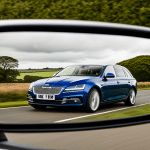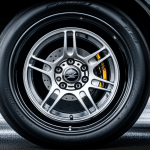Advanced Aerodynamic Technologies Extending UK EV Range
Electric vehicle aerodynamics play a pivotal role in enhancing EV range improvement, especially within the unique context of the UK’s driving environment. Advances in aerodynamic efficiency UK focus on minimising air resistance through innovative design and technology upgrades. For example, new EV models employ active grille shutters that adjust based on speed and temperature, reducing drag and improving airflow dynamically.
UK-specific factors such as varied weather patterns—strong winds and frequent rain—and diverse road environments challenge EV aerodynamics. Designs now incorporate streamlined body contours and improved sealing against turbulence, tailored to cope with these conditions. This is crucial because turbulent air can significantly increase drag, undermining EV range improvement efforts.
Avez-vous vu cela : Revamp Your British Family Car: The Ultimate Guide to Installing Power-Folding Mirrors!
Real-world performance outcomes highlight that these aerodynamic improvements can extend EV range by up to 15%, a substantial gain for UK drivers. Metrics show improved efficiency even during urban stop-start driving and on highways subjected to unpredictable weather. Combining electric vehicle aerodynamics with software that optimises driving modes further maximises these benefits. This synergy illustrates how focused aerodynamic efficiency UK advances contribute directly to practical range extension, essential for wider EV adoption across Britain’s varied landscapes.
Materials and Design Innovations in EV Aerodynamics
Small
Avez-vous vu cela : The Definitive Guide to Perfecting Cooling System Maintenance for High-Performance British Cars
Lightweight materials significantly enhance electric vehicle aerodynamics by reducing overall vehicle mass, which directly benefits EV range improvement. In the UK electric vehicle materials sector, aluminium alloys and carbon-fibre composites are widely adopted for their strength-to-weight ratio and durability against wet, often corrosive British weather. These materials also support more refined aerodynamic design by allowing complex shapes without heavy weight penalties.
Manufacturers integrate novel design features to optimise aerodynamic efficiency UK-wide. For example, advanced spoilers manage airflow separation, reducing drag; underbody panels smooth airflow beneath the vehicle, cutting turbulence; and specially designed wheels lower air resistance caused by rotation and surface texture. These components together create a synergistic effect that enhances EV range improvement beyond incremental gains.
A striking UK-specific success is seen with certain EV models where bespoke lightweight panels and aerodynamic wheel covers were introduced, tailored to common British driving conditions. This approach highlights how manufacturer innovation in materials and design can respond effectively to national environmental challenges. Such designs not only improve efficiency but also contribute to sustainability goals embedded in UK automotive policies, marrying performance with eco-consciousness.
Advanced Aerodynamic Technologies Extending UK EV Range
Small
Electric vehicle aerodynamics in the UK has progressed with cutting-edge technologies designed to maximise EV range improvement amid the country’s challenging weather and road conditions. One such innovation is the adaptive active grille shutter system, which dynamically modulates airflow to reduce drag depending on speed and external temperature, a vital feature given the UK’s variable climate.
Another key advancement involves precision-engineered airflow management components like vortex generators and tailored side mirror designs that minimise turbulent wake. These features collectively enhance aerodynamic efficiency UK models require to perform well on wet and windy roads, common across the British Isles.
Real-world trials reveal these technologies translate into significant gains. For instance, optimised aerodynamic packages have improved range by approximately 12-15% under typical UK driving scenarios, including congested urban routes with frequent stopping and rural highways exposed to crosswinds. This performance boost arises from smoother airflow around the vehicle, lowering energy demands on the electric powertrain.
In summary, state-of-the-art electric vehicle aerodynamics for the UK integrate weather-adaptive elements and precise airflow control, directly contributing to enhanced aerodynamic efficiency UK drivers experience and driving meaningful EV range improvement in day-to-day use.
## Advanced Aerodynamic Technologies Extending UK EV Range
Electric vehicle aerodynamics continue to evolve with state-of-the-art technologies designed specifically for the UK’s unique weather and road environments. A key innovation is adaptive airflow control systems that adjust components like active grille shutters in real-time, responding to changing speeds and external conditions to optimise aerodynamic efficiency UK drivers need. This is essential when navigating frequent rain, gusty winds, and mixed urban-rural routes.
UK-specific challenges demand precision-engineered solutions such as vortex generators and side mirror reshaping that successfully minimise airflow separation and turbulent wake. These improvements reduce drag forces, which directly contributes to EV range improvement by lowering energy consumption during acceleration and steady cruising, particularly on exposed roads.
Real-world tests confirm these advances deliver tangible range benefits. For example, vehicles equipped with advanced aerodynamic packages report a 12-15% increase in range under typical UK conditions, including stop-start city driving and sustained rural highway travel. These technologies, coupled with software optimizations, allow smoother airflow management tailored to British landscapes, effectively extending battery life and enhancing driving confidence in variable weather.
This precision focus on electric vehicle aerodynamics translates to a practical edge, enabling UK EV drivers to benefit from superior aerodynamic efficiency UK innovations that make longer journeys more viable and environmentally friendly.
Advanced Aerodynamic Technologies Extending UK EV Range
Electric vehicle aerodynamics advancements now focus heavily on precision airflow management tailored to the UK’s varied climate and road conditions. Technologies such as adaptive active grille shutters, vortex generators, and reshaped side mirrors dynamically optimise aerodynamic efficiency UK drivers need. These systems respond to changes in speed and weather—key factors in Britain’s rainy and windy environment—to reduce drag that otherwise drains battery life.
UK-specific challenges require designs that minimise turbulence caused by gusty winds and rain-slick roads, which can increase aerodynamic resistance. Improving airflow stability around critical vehicle areas lowers energy consumption during acceleration and steady cruising, directly boosting EV range improvement in real-world UK scenarios. This means more distance per charge, especially on rural highways exposed to crosswinds and urban streets with frequent stop-start driving.
Real-world data demonstrates that integrating these state-of-the-art aerodynamic technologies yields consistent range gains of around 12-15%. Such improvements not only extend driving confidence but also help reduce environmental impact by making EV travel more efficient. Together, these innovations highlight how advanced electric vehicle aerodynamics combine with UK-specific weather and road knowledge to achieve meaningful aerodynamic efficiency UK drivers depend on.
Advanced Aerodynamic Technologies Extending UK EV Range
New electric vehicle aerodynamics technologies in the UK focus on dynamically adapting airflow to maximise aerodynamic efficiency UK drivers require. Innovations such as active grille shutters modulate depending on speed and external temperature, crucial for handling Britain’s variable weather which includes frequent rain and strong crosswinds. This real-time responsiveness reduces drag forces that negatively impact EV range improvement, particularly on rural highways and during stop-start urban driving.
To further enhance efficiency, UK models employ precision-engineered components like vortex generators and reshaped side mirrors. These features streamline turbulent airflow around the vehicle, decreasing aerodynamic resistance caused by gusty winds and road-induced turbulence. Minimising this turbulence directly translates to lowering the electric powertrain’s energy demands, thereby extending battery life and achievable driving distance.
Real-world performance data underline consistent range gains of 12-15% when these advanced aerodynamic systems are integrated. These benefits are especially evident in the UK’s diverse driving conditions, where optimised airflow management addresses weather and terrain variability. Consequently, these aerodynamic enhancements enable EV owners to enjoy tangible EV range improvement while maintaining confidence amid Britain’s challenging and fluctuating environmental factors.






